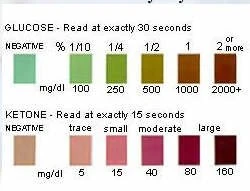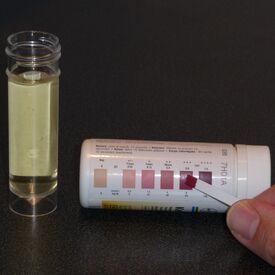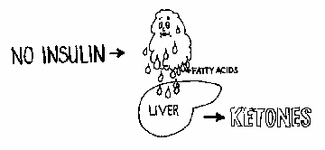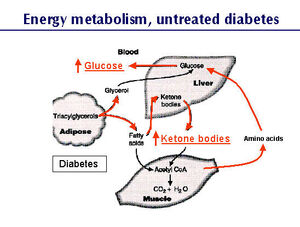
Chemical structures of various ketone bodies - acetone (top), acetoacetic acid (middle), and beta-hydroxybutyric acid (bottom).
Ketones in the urine or blood, as detected by urine testing stix or a blood ketone testing meter, [1] may indicate the beginning of diabetic ketoacidosis (DKA), a dangerous and often quickly fatal condition caused by low insulin levels [2] combined with certain other systemic stresses. DKA can be fixed if caught quickly.
Because of the hyperglycemia Cushing's disease creates, it's possible (but not frequent) to find ketones in the urine. [3]
The three ketone bodies are acetone, acetoacetic acid, and beta-hydroxybutyric acid, with the predominating ketone body formed being beta-hydroxybutyrate acid. [4] Though they are referred to as "bodies" this is a misnomer as they are dissolved substances. [5][6]
Ketones are produced by the liver as part of fat metabolism and are normally not found in sufficient quantity to be able to be measured in urine or blood (non-diabetics or well-controlled diabetics). [7] Since the body is set up to normally burn glucose as its fuel, when glucose isn't available as an energy source, (untreated/poorly treated diabetes and some other unrelated medical conditions), it begins to burn fat for energy instead. The result of the body turning to burning fat instead of glucose means more ketone production which is able to be measured when testing either urine or blood for them. [4][6]
| Ketone Bodies [8][9] | |||
|---|---|---|---|
| Acetoacetate | Percentage of Ketones Produced 20% |
Detected in Urine |
Urine Ketone Testing Materials |
| Beta-hydroxybutyrate acid | Percentage of Ketones Produced 76% |
Detected in Blood | Blood Ketone Testing Materials |
| Acetone | Percentage of Ketones Produced 2% |
Detected on Breath | Fruity or nail-polish remover odor Testing breath samples for acetone with gas chromatography. [10][11] |
Emergency Info[]
Diabetics of all species therefore need to be checked for ketones with urine testing stix, available at any pharmacy, whenever insulin level may be too low, and any of the following signs or triggers are present:
| Ketone Monitoring Needed: | |
|---|---|
| High blood sugar | over 14 mmol/L or 250 mg/dL (with low insulin, lower as well...) |
| Dehydration | (skin doesn't jump back after pulling a bit [12] gums are tacky or dry) [13] |
| Not eating for over 12 hours | due to Inappetance or Fasting |
| Vomiting | |
| Lethargy | |
| Infection or illness [14] | |
| High stress levels | |
| Breath smells like acetone (nail-polish remover) or fruit [15]. | |
Note that the triggers and signs are somewhat interchangeable because ketoacidosis is, once begun, a set of vicious circles which will make itself worse. So dehydration, hyperglycemia, fasting, and presence of ketones are not only signs, they're also sometimes triggers.
|
In a diabetic, any urinary ketones above trace, or any increase in urinary ketone level, or trace urinary ketones plus some of the symptoms above, are cause to call an emergency vet immediately, at any hour of the day. | ||
How to check[]

Ketodiastix--measures urine glucose and ketones.

Ketostix-measures urine ketones. This color key works with the ReliOn brand ketone urine test strips also as both are made by Bayer.
When testing urine for ketones, the sample needs to be as fresh as possible. Ketones evaporate quickly, so there's a chance of getting a false negative test result if you're testing older urine. [16] The stix [17] bottle has instructions and color charts to show you how the color on the stix will change given the level of ketones/glucose in the urine over 15 (ketones-Ketostix) or 30 (glucose-Ketodiastix) seconds. Be sure to read the colors at those time intervals because the colors will continue to darken and a later reading will be an incorrect result. Timing with a clock or watch second hand instead of counting is said to be more accurate/ [18] The Bayer-made, ReliOn branded ketone urine test strips sold by Wal-Mart and Sam's Club have the same instructions and color key as the Bayer brand, Ketostix. [19]
It's important to time the test accurately and not take into account any color changes on the Ketostix strip which occur after 15 seconds. [20]
At low levels, ketones can be detected in the urine (ketonuria) before they are found in the blood (ketonemia/ketonaemia). [21]
Most urine tests for ketones measure acetoacetic acid, not the most common beta-hydroxybutyrate acid. [4]
False Testing Results-Urine Ketones[]
|
Because most urine tests measure acetoacetic acid, and not the most commonly found beta-hydroxybutyrate acid, it is possible to have ketones present and get a negative urine test result. Further, it's also possible to have high levels of beta-hydroxybutyrate acid, get a negative urine ketone test result, but to have the test turn positive as the ketosis improves, due to the tests' measuring acetoacetic acid and not beta-hydroxybutyrate acid. [4] | ||
|
Possible False Urine Ketone Test Results--Drugs and Supplements | |
|---|---|
| Valproic Acid (brand names) Depakene, Depakote, Divalproex Sodium [22] |
Positive. Common use: Treatment of epilepsy. |
| Cefixime/Suprax [23] | Positive with nitroprusside-based urine testing. Common use: Antibiotic. |
| Levadopa Metabolites [24] | Positive with high concentrations [16][25]. |
| Tricyclic Ring Compounds [26][27] | Positive. Common use: Treatment of depression. |
| Captopril- other drugs with free sulfhydryl groups [26] |
Positive. Captopril Common use: Hypertension (high blood pressure), various heart conditions, preserving kidney function in diabetic nephropathy [28][25]. |
| Phenazopyridine Pyridium, Geridium, Pyridiate, or Urogesic [29][30]. |
Positive. Common use: Urinary tract infections. |
| Glucocorticoids/Steroids [31] | Positive. Common use: Allergies, replacement therapy, others. |
| Vitamin C Supplements [32][25][20]. | Negative. |
|
Possible False Urine Ketone Test Results-Other Reasons | |
|---|---|
| Pigmented Urine [16] | Positive- Any other color except yellow or clear[33] May be the result of other disease processes. |
| Dehydration [29][34] | Positive or negative lack of fluids can concentrate ketones |
| samples with high specific gravity and low pH [35] |
Positive. |
| Old Urine Sample [16] | Negative- ketones can evaporate rapidly. |
| Older opened test strip container [36][20] | Negative |
If your pet is taking any type of vitamin supplements, it should be noted on his or her medical records. Knowing that he/she is using them means being able to factor them into interpretations of test results.
When to come to the vet[]

Serious ketones detected in urine with Ketostix. The color of the test pad matches 80, or Large, on the Ketostix color chart. Medical intervention is needed right away.
Trace urinary ketones may or may not be an emergency, depending on the case. If a vet is unavailable, look for some of the other signs or triggers, and try to remedy any you can. Give extra water and food, by syringe if necessary. If it's nearly time for an insulin shot, give one. Continue testing and call a vet when possible.
DKA cannot be treated at home. Veterinary care for DKA involves intravenous (IV) fluids to counter dehydration [37] and flush the animal's system of the ketones [38] and when necessary, to replace depleted electrolytes, [39][40][41][42] such as bicarbonate; [43] intravenous or intramuscular [44] fast-acting insulin to bring the blood glucose levels down; [45][46][47] measured amounts of glucose or force feeding, sometimes by feeding tube, to force the metabolism back from fat-burning to glucose-burning.[6]
Many times, the polyuria of hyperglycemia and ketosis means too much potassium leaves the system via the too-frequent urination, so it's possible for the body to be low on potassium because of it. However, insulin's other use besides controlling blood glucose, is when a patient has too much potassium, or hyperkalemia. [48]
What happens then is we have someone whose potassium levels are low from too much urination and who must have insulin to manage blood glucose levels, with the knowledge that the use of the needed insulin will further deplete the potassium in the system. [49] Many doctors opt to use Ringer's with additional potassium to bring the body back into balance. [50]
Dehydration becomes involved with ketoacidosis, which can mean that subcutaneous insulin injections are not properly absorbed; [51] when this occurs, intravenous treatment with soluble, short-acting insulin is needed. [52], along with rehydrating intravenous fluids [53]
Dr. Michael Herrtage describes the situation well in his WSAVA presentation, "In diabetic ketoacidosis, there are serious derangements in fluid, electrolyte and acid-base status." [44]
Veterinary care for DKA may involve a hospital stay of five days or more and cost, in the U.S., $2,000 or more. Some animals are DKA prone, and may have multiple episodes of the condition.
Veterinarians have sometimes been known to send pets home from a DKA episode while still displaying ketones in the urine due to owner financial constraints -- this can turn into a fatal mistake. Your chances of fixing the problem yourself are slim. If your cat or dog comes back from the hospital and still has ketones showing on urine testing stix, it's usually best to find the financial means to go right back to the vet's as your pet may need to stay in hospital longer.
How it happens[]

When there's not enough insulin to allow conversion of glucose to energy, the body begins to break down fat cells, which produce fatty acids. These fatty acids are converted to ketones which can fuel the brain in emergencies.
Our bodies normally are "fueled" by burning glucose; they are able to do this provided they have enough insulin (normally or by injection). When there's not enough insulin to allow the body to burn glucose for energy, it begins metabolizing fat to fuel its cells. In particular, the brain cannot go without energy even for a second, so it demands fat conversion to ketones when glucose energy is unavailable. [54] Continuing this process using fat and ketones instead of glucose without sufficient insulin intervention is the path to ketoacidosis.[6]
Adapted from the Wikipedia:

Energy Production-Untreated/Inadequately Treated Diabetes-without enough insulin to regulate fat & carbohydrate metabolism, the process intensifies. The liver, despite high blood glucose levels, produces still more in gluconeogenesis. It also speeds up the transformation of fatty acids resulting in ketones.
Normally, ketone bodies are produced in minuscule quantities, feeding only part of the energy needs of the heart and brain. When insulin is inadequate, fat must be turned into ketones for energy instead, and they rapidly become a major component of the brain's fuel. As a result, the bloodstream is filled with an increasing amount of glucose that it cannot use (as the body continues adding glucose to the blood with gluconeogenesis and perhaps also glycogenolysis). This extra glucose significantly increases its osmolality.
At the same time, massive amounts of ketone bodies are produced, which in addition to increasing the osmolal load of the blood, are acidic. As a result, the pH of the blood begins to change. The trace element balance of the system is altered by falling bicarbonate blood levels and rising serum potassium levels. The potassium level of the body as a whole is reduced by the polyuria of ketoacidosis. [55][56] There can be changes in breathing (deep, sighing breaths) because the ketones themselves are acids. Any type of acidosis can affect the respiratory system.[6]
Glucose begins to spill into the urine as the proteins responsible for reclaiming it from urine reach maximum capacity. As it does so, it takes a great deal of body water with it, resulting in dehydration. [50] The over-frequent urination takes vital minerals such as salt and potassium with it.[6] These are known as electrolytes [57] and the right balance of them controls many automatic body functions, such as heartbeat, etc. [58][43] Dehydration worsens the increased osmolality of the blood, and forces water out of cells and into the bloodstream in order to keep vital organs perfused.[6] The vicious cycle is now set, and if untreated will lead to coma and death. [59]
How likely is it?[]
Since diabetic dogs are considered insulin-dependent--unable to naturally provide any of their own insulin needs once diagnosed with diabetes--they are prone to ketoacidosis. [60] About 40% of newly-diagnosed canine diabetics have some amount of ketones when they are brought to the vet. [61]
Ketones occur quickly in younger animals. [16]
Testing for ketones-blood and urine[]
The usual method of testing for ketones is with urine testing stix, available at any pharmacy. When testing urine for ketones, the sample needs to be as fresh as possible. Ketones evaporate quickly, so there's a chance of getting a false negative test result if you're testing older urine. [16]
At low levels, ketones can be detected in the urine (ketonuria) before they are found in the blood (ketonemia/ketonaemia). [62]
At present there is only one device for consumers who wish to test blood instead of urine for ketones--Abbott's Precision Xtra glucometer. [63] The meter is known by the brand name Precision/Optimum/Xceed outside of the US. [64][65]
The premise behind blood testing for ketones is the same as that for favoring glucose testing of blood over urine. [66][67][18] The urine ketone measurement, like urine glucose measurement, can be hours old; testing blood for both gives current values as of testing time. [68][69][70][71][72]
Testing blood for ketones also means there are less medications and other things like lipids which can interfere with the accuracy of the test. [73] Children with Diabetes [74] advises every family with a child with diabetes should have this type of meter because of its blood ketone testing ability. The ketone test strips are about $30 for 10 individually-wrapped strips. The Precision Xtra also does blood glucose testing with standard blood glucose test strips made for use with the meter.
Most urine tests for ketones measure acetoacetic acid, which is 20% of the ketones produced. [9] not the most common beta-hydroxybutyrate acid[4] Blood testing for ketones measures beta-hydroxybutyrate acid, [18] which is 76% of the ketones produced. [9] Testing blood for ketones would provide a more accurate picture of the problem at the moment, similar to the comparison between blood testing for glucose vs urine testing.
Good BG Readings but Positive Ketone Results[]
When the bg readings are high enough to produce some ketones, you've taken action to bring them down and they are normal once more, it is possible to still see some positive urine ketone test results. Ketones show up in the urine right away. When you're getting normal bg readings, it means that there are no more ketones being produced. What you are seeing when you test urine for ketones and the blood glucose is in normal ranges are the "leftovers" of the ketones which were produced by the high bg episode. They will continue to show up in the urine for a while but their concentration will become less and less until they're gone. [75][76][77]
Other notes[]
While the cause of the hyperglycemia which began the ketoacidosis may be suspected Cushing's disease, any testing done for the disease until the ketoacidosis episode has passed will result in false positive reports. These tests can't be run until a minimum of 2 weeks after a ketoacidosis episode to receive valid results.[78]![]()
References[]
- ↑ Blood Ketone Testing Meter--Abbott's Precision Xtra. Children With Diabetes.
- ↑ Hanas, Ragnar. Ketones Increase With Lack of Insulin. Children With Diabetes.
- ↑ Schermerhorn, Thomas (2001). Persistent Hyperglycemia in Dogs and Cats-page 11. Standards of Care-Compendium.
- ↑ 4.0 4.1 4.2 4.3 4.4 Ketones. Patient.co.uk. Cite error: Invalid
<ref>tag; name "Patient" defined multiple times with different content Cite error: Invalid<ref>tag; name "Patient" defined multiple times with different content Cite error: Invalid<ref>tag; name "Patient" defined multiple times with different content - ↑ Ketone Body. Wikipedia.
- ↑ 6.0 6.1 6.2 6.3 6.4 6.5 6.6 Tabor, Kim (February 2011). Diabetic Ketoacidosis. Veterinary Technician.
- ↑ Schall, William (2009). Diabetes mellitus CVC Proceedings. DVM 360.
- ↑ Detection of Ketones and Monitoring of Diabetic Ketoacidosis-cov-7. Managed Care Magazine (2004).
- ↑ 9.0 9.1 9.2 Ketone Bodies. NDI Foundation.
- ↑ Musa-Veloso, Kathy, Likhodii, Sergei S., Cunnane, Stephen C. (July 2002). Breath acetone is a reliable indicator of ketosis in adults consuming ketogenic meals. American Journal of Clinical Nutrition.
- ↑ Gas chromatography. Wikipedia.
- ↑ Assessing Dehydration Through Skin Elasticity. Pet Education.com.
- ↑ Water: A Nutritional Requirement. Pet Education.com.
- ↑ Ketosis. Novo Nordisk.
- ↑ Ketoacidosis. American Diabetes Association-Ketoacidosis.
- ↑ 16.0 16.1 16.2 16.3 16.4 16.5 Sine, Cheryl S, et. al. (2003). Urinalysis Dipstick Interpretations-Ketones. University of Georgia. Cite error: Invalid
<ref>tag; name "Sine" defined multiple times with different content Cite error: Invalid<ref>tag; name "Sine" defined multiple times with different content Cite error: Invalid<ref>tag; name "Sine" defined multiple times with different content Cite error: Invalid<ref>tag; name "Sine" defined multiple times with different content - ↑ Ketone Strips. Diabetes Self-Management.
- ↑ 18.0 18.1 18.2 Chase, Peter. Ketone Testing. Barbara Davis Center for Diabetes. Cite error: Invalid
<ref>tag; name "Chase" defined multiple times with different content Cite error: Invalid<ref>tag; name "Chase" defined multiple times with different content - ↑ ReliOn Ketone Urine Test Strips Instructions. ReliOn/Bayer.
- ↑ 20.0 20.1 20.2 Hanas, Ragnar. Measuring Ketones in Urine. Children With Diabetes. Cite error: Invalid
<ref>tag; name "HanasUrine" defined multiple times with different content Cite error: Invalid<ref>tag; name "HanasUrine" defined multiple times with different content - ↑ Subramonian, Kesavapillai, et. al.. Glycosuria and Ketonuria. BMJ Student Archive.
- ↑ Valproic Acid. NetDoctor UK.
- ↑ Suprax/Cefixime. RXList.com.
- ↑ Levadopa. Drugs.com.
- ↑ 25.0 25.1 25.2 Hanas, Ragnar. Measuring Ketones in Blood. Children With Diabetes.
- ↑ 26.0 26.1 Taylor, Judith A. (November 2006). Clinical Lab Medicine Harvesting The Gold: Interpretation and Techniques of Urinalysis. District of Columbia Academy of Veterinary Medicine.
- ↑ Tricyclic Antidepressant. Wikipedia.
- ↑ Captopril. Wikipedia.
- ↑ 29.0 29.1 Ketone Test Explained. Diabetes Explained. Cite error: Invalid
<ref>tag; name "Explained" defined multiple times with different content - ↑ Phenazopyridine. Merck Manuals Online.
- ↑ Ketones. Medline Plus.
- ↑ Precision Xtra Blood Ketone Test Strips. Abbott Diabetes Care.
- ↑ Taylor, Judith A. (November 2006). Urinalysis: What Is Abnormal?. District of Columbia Academy-Veterinary Medicine.
- ↑ Dehydration and Ketosis. North American Veterinary Conference (2003).
- ↑ Preanalytical Variables in Urine Testing. BD Diabetes (2006).
- ↑ Precision Xtra-When is it Recommended to Test?. Abbott Diabetes Care.
- ↑ Schall, William (2009). Diabetes Mellitus-CVC Proceedings-Fluids. DVM 360.
- ↑ Durkan, Samuel (2008). Endocrine Emergencies. DVM 360.
- ↑ Potassium Requirements & Deficiencies. Pet Education.com.
- ↑ Sodium & Chloride Requirements & Deficiencies. Pet Education.com.
- ↑ Hypokalemia-Low Blood Potassium. RxEd.org.
- ↑ Schermerhorn, Thomas (January 2008). Treatment of Diabetes Mellitus in Dogs and Cats. NAVC.
- ↑ 43.0 43.1 Stoeppler, Melissa Conrad. What Are Electrolytes?. MedicineNet. Cite error: Invalid
<ref>tag; name "Stoeppler" defined multiple times with different content - ↑ 44.0 44.1 Herrtage, Michael (2009). New Strategies in the Treatment of Canine Diabetes Mellitus-Insulin Therapy. WSAVA. Cite error: Invalid
<ref>tag; name "Herrtage" defined multiple times with different content - ↑ Connally, HE (2002). Critical Care Monitoring Considerations for the Diabetic Patient-Clinical Techniques in Small Animal Practice. Clinical techniques in small animal practice.
- ↑ Chastain CB, Nichols CE. (1981). Low-dose Intramuscular Insulin Therapy for Diabetic Ketoacidosis in Dogs. Journal of the American Veterinary Medical Association.
- ↑ Wortinger, Ann (February 2001). Electrolytes, Fluids and the Acid-Base Balance. Veterinary Technician.
- ↑ Insulin. InChem.
- ↑ Schall, William (2009). Diabetes Mellitus-CVC Proceedings-Electrolytes. DVM 360.
- ↑ 50.0 50.1 Fluid Therapy. Washington State University School of Veterinary Medicine. Cite error: Invalid
<ref>tag; name "Fluid" defined multiple times with different content - ↑ Heinemann, Lutz (January 2008). Variability of Insulin Action:Does It Matter?-page 40 (4 of 9). Insulin Journal.
- ↑ Pediatric Endocrine Emergency Answer Sheet. American College of Emergency Physicians.
- ↑ Diabetes Mellitus-Ketoacidosis. Merck Veterinary Manual.
- ↑ Energy Metabolism Explained.
- ↑ Nussey, SS, Whitehead, SA. (2001). Endocrinology-An Integrated Approach-Ketoacidosis. NBCI Bookshelf.
- ↑ Davidson, Gigi (2000). Providing Care for Diabetic Veterinary Patients-page 2. IJPC.
- ↑ Electrolytes. How Stuff Works.
- ↑ DKA. Diabetes Self Management.
- ↑ Schall, William (2009). Diabetes Mellitus-CVC Proceedings-Pathophysiology of Type I Diabetes in Dogs. DVM 360.
- ↑ Better Medicine-E-Newsletter. Intervet (June 2006).
- ↑ Fleeman, Linda, Rand, Jacqueline (2005). Beyond Insulin Therapy: Achieving Optimal Control in Diabetic Dogs. University of Queensland.
- ↑ Subramonian, Kesavapillai, et. al.. Glycosuria and Ketonuria. BMJ Student Archive.
- ↑ Abbott's Precision Xtra. Abbott Diabetes Care.
- ↑ Abbott's Precision/Optimum/Xceed. Abbott Diabetes Care.
- ↑ Abbott Optimum Xceed. Abbott Diabetes Care.
- ↑ Naunheim, Rosanne, et. al. (June 2006). Point of Care Test Identifies Diabetic Ketoacidosis at Triage. Academic Emergency Medicine.
- ↑ O'Donohue, PB, et. al. (October 2006). Exploring the Clinical Utility of Blood Ketone Levels in ER Department Assessment of Pediatric Patients. Emergency Medicine Journal.
- ↑ Hanas, Ragnar. Value of Testing Blood for Ketones Over Testing Urine. Children With Diabetes.
- ↑ Byrne, HA, et. al (2000). Evaluation of an Electrochemical Sensor for Measuring Blood Ketones. Diabetes Care 2000.
- ↑ Guerci, Bruno, et. al. (2003). Accuracy of an Electrochemical Sensor for Measuring Capillary Blood Ketones by Fingerstick Samples During Metabolic Deterioration After Continuous Subcutaneous Insulin Infusion Interruption in Type 1 Diabetic Patient. Diabetes Care.
- ↑ Duarte, Ricardo, et. al. (2002). Accuracy of Serum β-Hydroxybutyrate Measurements for the Diagnosis of Diabetic Ketoacidosis in 116 Dogs. Journal of Veterinary Internal Medicine.
- ↑ M. Di Tommaso, G. Aste, F. Rocconi, C. Guglielmini, A. Boari (2009). Evaluation of a Portable Meter to Measure Ketonemia and Comparison with Ketonuria for the Diagnosis of Canine Diabetic Ketoacidosis. Journal of Veterinary Internal Medicine.
- ↑ Measuring Ketones in Blood. Children With Diabetes.
- ↑ Meter Which Tests Blood for Ketones-Precision Xtra. Children With Diabetes.
- ↑ Hanas, Ragnar. Insulin Dependent Diabetes in Children, Adolescents and Adults-page 11-Important-Ketones. Children With Diabetes.
- ↑ Hanas, Ragnar. Urine Ketones Decrease Slowly. Children With Diabetes.
- ↑ Ketone Detection. DiabetesNet.
- ↑ Huang, Alice, Scott-Moncrieff, J. Catherine (April 2011). Canine Ketoacidosis. Clinician's Brief.page 3
More Information[]
- Surviving diabetic Ketoacidosis North American Veterinary Conference-2006
- A chapter about ketone testing from the tenth edition of Understanding Diabetes Chase, H. Peter
A book about living with insulin-dependent diabetic humans. - Wikipedia:Diabetic Ketoacidosis
- Treating the Complicated Diabetic Patient Church, David B., 2001, WSAVA 2001
- Understanding Diabetic Ketoacidosis Schermerhorn, Thomas, 2005, WSAVA
- Emergency veterinary hospitals worldwide
- Metabolic Changes in Diabetic Ketoacidosis Dean, L., McEntyre J., 2004, The Genetic Landscape of Diabetes
- Ketones Diabetes Now UK.
Written for people but contains a lot of good information applicable to diabetes in pets also. - Blood Ketones LabTests Online
- Diabetic Ketoacidosis-A Medical Emergency Southpaws
- Fluid and electrolyte therapy in endocrine disorders: diabetes mellitus and hypoadrenocorticism Veterinary Clinics of North America 2008
- Urine Ketone Test Information-Multistix Cornell University
- New Insights into the Management of Diabetic Ketoacidosis Duarte, Ricardo, 2009, WSAVA
- Diabetic Ketoacidosis Church, David B., 2009, WSAVA
- Acid-Base Abnormalities in Dogs with Diabetic Ketoacidosis: A Prospective Study of 60 Cases Duarte, Ricardo, et. al., 2009, WSAVA
- Diabetic crises: Recognition and management (Proceedings) Macintire, Douglass, April 2008, DVM 360
- Endocrine emergencies (Proceedings) Durkan, Samuel, October 2008, DVM 360
| This page uses Creative Commons Licensed content from Wikipedia (view authors). | 
|
